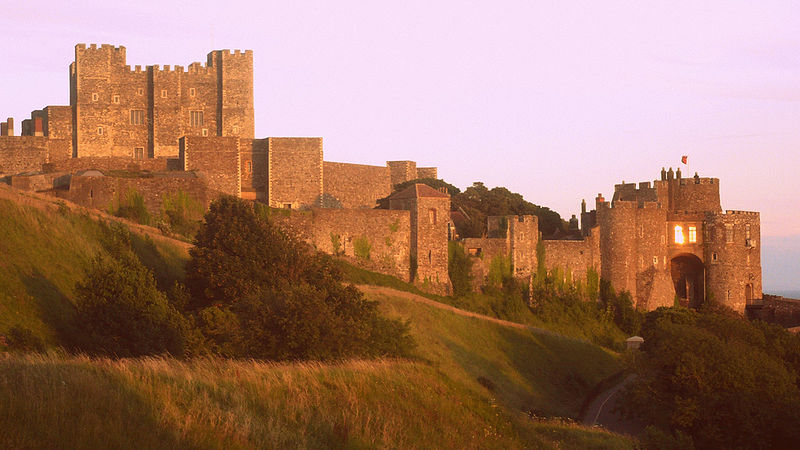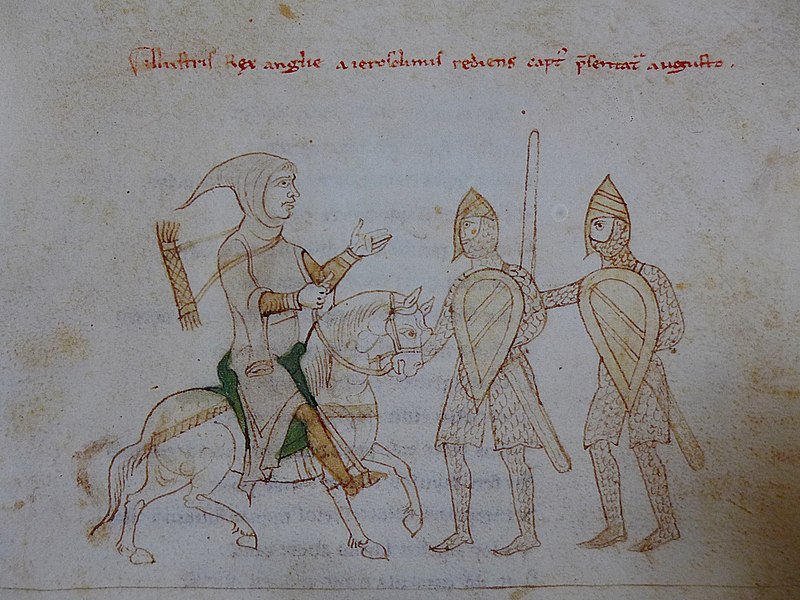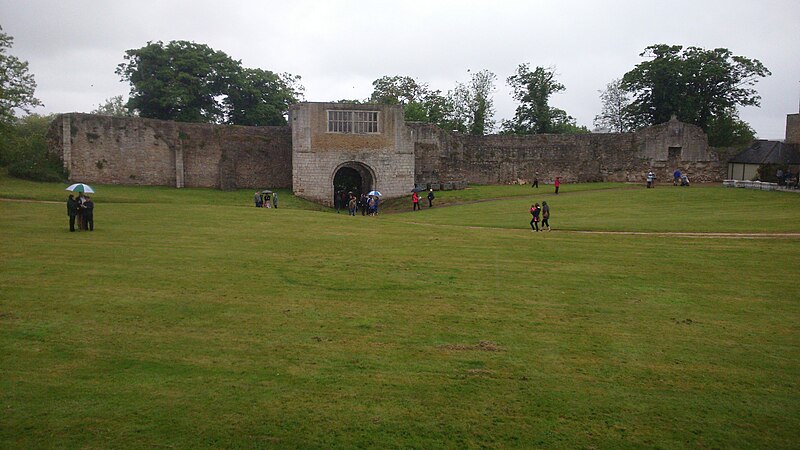 |
| Nottingham Castle (Victorian reconstruction) |
On 30th March 1194 Richard presided at a meeting of the Great
Council at Nottingham Castle; Geoffrey was present along with his stepmother,
Hugh de Puiset, William Longchamp and Hugh of Lincoln. The great matter before
the council was what to do with Prince John who was in cahoots with Philip of
France. Longchamps was given back his old job as Chancellor while Richard paid
a ransom for the return of Walter de Coutances
‘Laden
with men, horses and arms.’[i]
Richard intended to win back his lands in Normandy, seized by Philip
while Richard was in custody. Neither Richard nor his mother were to return to England.
Instead he was to be embroiled fighting Philip and draining money from England
in times of economic difficulty. Before Richard left England he appointed Walter as Justiciar.
In the
summer, very possibly as a result of Geoffrey’s attempts to claim seniority of
York over Canterbury, Walter began an investigation into Geoffrey's actions. Walter’s
commission reported back that very little of Geoffrey’s time was wasted on clerical affairs, instead he
spent his time hawking or hunting.
Geoffrey’s quarrels with his
cathedral clergy had worsened to the point that, in one instance a member of
the cathedral chapter threw the chrism on a dungheap in protest. The canons also objected to Geoffrey
giving a large part of York's treasury toward Richard's ransom and they
objected to some of his appointments in the church of York.
This led to
Geoffrey's estates being confiscated once again. The canons Geoffrey had
excommunicated were reinstated and Geoffrey was ordered not to issue sentences
against canons without the consent of the whole body of canons.
At the end
of 1194 Geoffrey left England to appeal directly to the king who by then was in
Maine. Richard over-ruled Walter, restored
Geoffrey's estates, and pardoned him in return for a payment of 1,000 marks and
the promise of 1,000 more to follow.
A Disputatious Cleric
In January 1195 Geoffrey was ordered to appear in Rome to answer charges of simony, extortion, and neglect of his duties lodged against Geoffrey by Puiset’s supporters. The ringleaders had been excommunicated by Geoffrey who had also locked the canons out of the Minster. Geoffrey was threatened with suspension from office if he did not appear by 1st June.
Geoffrey complained to the
king, who was sympathetic until Geoffrey started rebuking Richard for his
immoral life. Richard flew into a rage and confiscated Geoffrey’s estates once
again. This loss of his estates left Geoffrey vulnerable when Walter held a legatine council at York in June 1195.
Geoffrey had managed to secure
a postponement of his case at Rome until 1st November, but was still
unable to attend, which led Pope Celestine to order that Geoffrey's suspension
should be actioned by Hugh of Lincoln. Hugh protested, and as a result
Celestine himself suspended Geoffrey on 23rd December 1195, finally
forcing Geoffrey to answer the charges against him. He travelled to Rome in
1196, where his accusers were unable to substantiate their claims and he was
restored to office by the pope.
News of Import
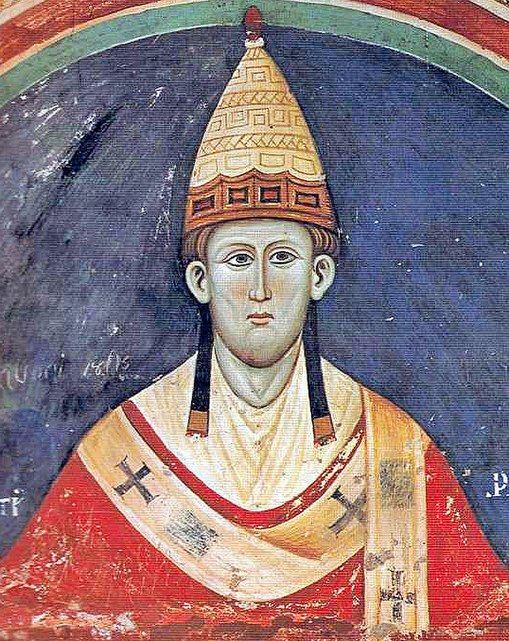 |
| Innocent III |
Eventually the new Pope Innocent III ordered on 28 April 1199 that Geoffrey was to be restored to his lands as soon as he had paid his debts to the king. Innocent further stipulated that any royal appointments in York would require papal approval.
Geoffrey’s
canons were mixed in their response to the return of their archbishop. One,
Simon Murdac announced that he would be happy to see Geoffrey return to his
archdiocese. But Murdac was immediately excommunicated by the Dean, Simon of
Apulia.
Before the
pope could make any new rulings on the dissension between Geoffrey and his
canons, the news arrived; Richard was dead. Richard died on 7th
April 1199, after a wound from a stray quarrel turned gangrenous. The lucky
shot came from one of the defenders of the chateau of Châlus- Chabrol, that Richard was besieging,. It was now the turn of Henry
II’s youngest son to reign over the empire he had wrought.
John defies the Pope
 |
| Stephen Langton |
In July 1205
Hubert Walter died and John tried to replace him with one of his own supporters[ii]
who was rejected by the cathedral chapter. The stalemate continued until the
end of 1206 when Innocent III nominated Stephen Langton. John refused Langton entry to the country[iii].
John threw out the monks of Canterbury and seized the cathedral revenues.
John and
Geoffrey had enjoyed a relatively benign relationship when they were both
younger and when he came to the throne John was prepared to be conciliatory to
Geoffrey. He had enough on his plate with Arthur of Brittany also claiming his
throne[iv].
Caught between John and Philip Arthur ended up flip-flopping to pay homage to
Philip.
In an
attempt to sort the problems emanating from York, John summonsed Simon of
Apulia to attend his court at Westminster. Simon was persuaded to accept
Geoffrey as his archbishop. In return Geoffrey recognised Simon as Dean of the
chapter. On their return to York, when the Archdeaconry of Cleveland[v] fell vacant, the two men fell out
again.
Geoffrey
nominated one of his followers, but Simon nominated Hugh Murdac. Infuriated and
his Angevin temper soaring, Geoffrey excommunicated the hapless Murdac. Both
sides appealed to John who summonsed his brother to accompany him to France.
Stupidly Geoffrey ignored the summons.
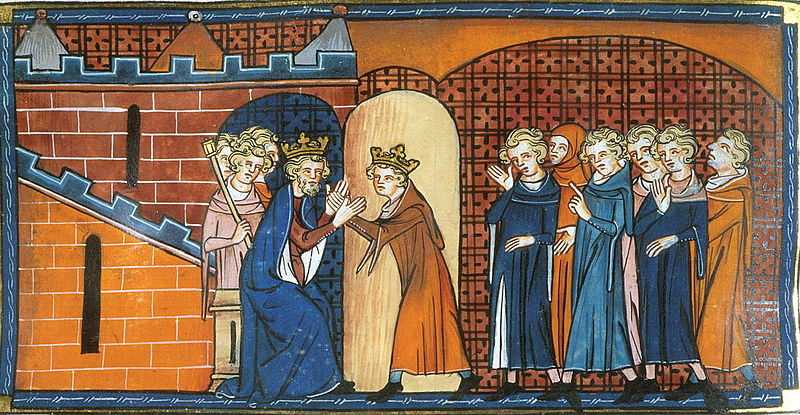 |
| Arthur pays homage to Philip |
Around the
same time Geoffrey fell out with John over taxation issues and refused to allow
his clergy to pay John’s latest tax raising whiz. The church’s lands were
seized and Geoffrey and his clergy knelt before John to plead with him for a
reversal of the seizures. Gervase of Canterbury recorded;
‘The king, in truth, threw
himself at the archbishop’s [Geoffrey] feet and laughing and jeering said “Look
my lord archbishop, even as you do so do I.”’[vi]
In the
summer of 1207 Geoffrey fled abroad, followed by a number of the senior bishops.
John seized his brother’s estates. Innocent III put the country under an interdict forbidding the clergy to take services[vii].
He also threatened to excommunicate John.
Under Interdict
 |
| King John |
On 17th
March 1208 John’s officers commenced their task of seizing church properties. By
September the king was taking hostages from nobles whose loyalty was suspect. Roger of Wendover wrote;
‘King John….was afraid that,
after the interdict, our lord pope would excommunicate him or absolve the
nobles of England from allegiance to him. He therefore sent an armed force to
all men of rank….and demanded hostages of them.’[viii]
On 27th
May 1208 Innocent ordered an interdict on York should John fail to restore
Geoffrey’s property. In August he wrote to both John and Geoffrey deploring
their quarrel. Because of Geoffrey’s stance Geoffrey
of Coldingham, a
chronicler, claimed that the church in England church considered Geoffrey a
martyr.
 |
| Otto IV greets Innocent III |
Innocent
excommunicated John in November 1209. John retaliated by taking over £100,000
worth of money from the clergy over the next two years. John’s treasury
appropriated the revenues of the empty benefices and managed to raise enough
money[ix]
to fund ill-advised adventures abroad.
As well as
raising the country’s military state of readiness, John set up a series of
alliances to help defend his continental possessions. He allied with his nephew
Otto IV the Holy Roman Emperor, Charles I, the Count of Flanders and a number of northern European Dukes.
Geoffrey’s
final years were spent in exile; Geoffrey died on 12th December 1212[x],
at the monastery[xi]
at Notre Dame du Parc near Rouen. He was buried there. Geoffrey
was a disappointed man whose arrogance had cost him dear.
Bibliography
Philip
Augustus – Jim Bradbury, Longman 1998
King John –
Stephen Church, MacMillan 2013
Early
Medieval England – MT Clanchy, The Folio Society 1997
Richard the
Lionheart – John Gillingham, George Weidenfeld and Nicholson 1989
The Royal
Bastards of Medieval England – Chris Given- Wilson and Alice Curteis, Barnes
& Noble Books 1995
The
Plantagenets – Dan Jones, William Collins 2012
Absolute
Monarchs – John Julius Norwich, Random House 2011
King John –
WL Warren, Yale University Press 1997
Eleanor of
Aquitaine – Alison Weir, Jonathan Cape 1999
The
Plantagenets – Derek Wilson, Quercus Editions Ltd 2014
[i]
Philip Augustus - Bradbury
[ii]
The monks nominated Reginald,
the Sub-Prior, who was set
aside by John. They then nominated John de Gray, Bishop of Norwich,
who was set aside by the pope.
[iii]
It was not until six years later that Langton was allowed into the country
[iv]
As the only child of one of John’s older brothers. In 1202, in conjunction with
Philip, Arthur waged war on Normandy
[v]
One of the riches benefices in the York Archdiocese
[vi]
King John - Warren
[vii]
No-one could get christened, married or buried in consecrated ground.
[viii]
King John - Church
[ix]
Over £100,000; Comparisons of wealth are not calculated for before the year
1270, if these monies had been extracted then not in 1211-12, then In 2014 the
relative: historic standard of
living
value of that income or wealth is £85,460,000.00 labour earnings of that income or wealth is
£1,508,000,000.00 economic status value of that income or wealth is £3,572,000,000.00, economic power value of that income or
wealth is £29,120,000,000.00 www.measuringworth.com
[x]
The month before Geoffrey died John had agreed to accept Langton as his
archbishop of Canterbury.
[xi]
The monastery was of the Grandmontine
order; Henry II had encouraged the order to set up the monastery there and tend
to the leper house which he had set up on the site of his old hunting lodge
